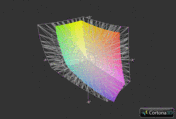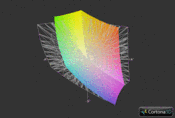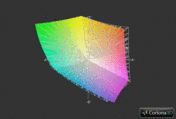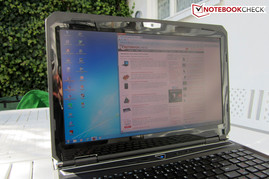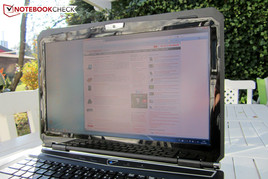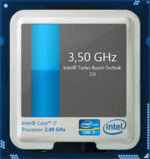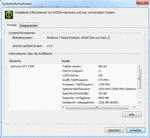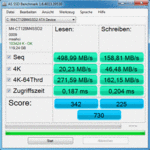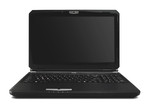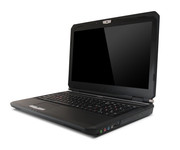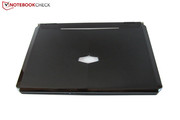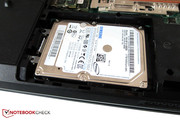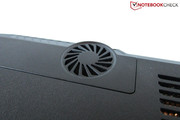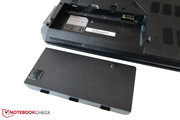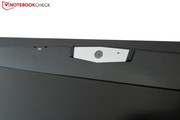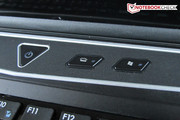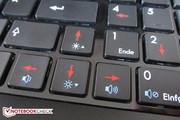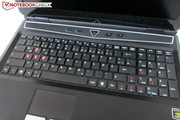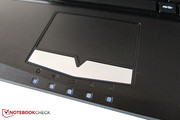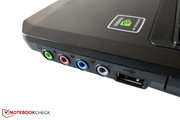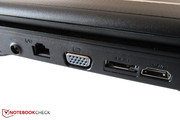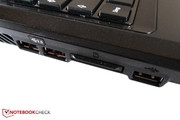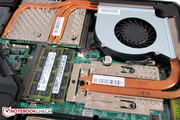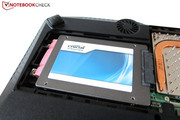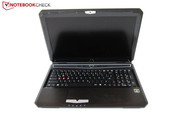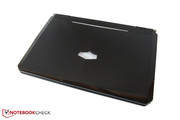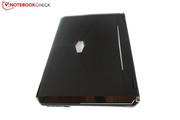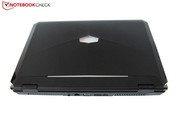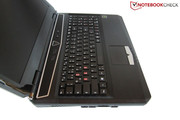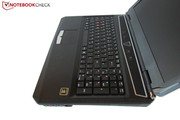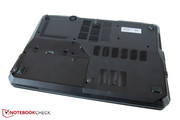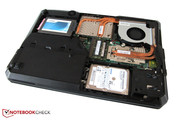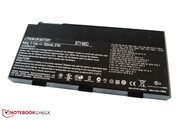Review Schenker XMG P511 Notebook
Schenker Notebooks have had various interesting devices in its range in the past. For example, we happily remember the well-designed all-rounder, XMG A501 or the powerful gaming behemoth XMG P501. They were both based on a barebone from the Taiwanese notebook expert Clevo. However, Schenker uses a case from MSI (MS-16F2) for the XMG P511. Although the MSI barebones can't quite hold a candle to the Clevo opponents, the price-performance ratio is almost unbeatable.
As known from Schenker, the gaming laptop can be configured in detail on Schenker's homepage. Starting with the processor, where the buyer has to choose between a dual and quad core. Almost the entire Intel product range can be found - starting with the affordable entry level model, Core i3-2330M, up to the wickedly expensive premium model, Core i7-2960XM. We would recommend the Core i7-2670QM because it's not overly expensive and can serve with four cores.
Schenker uses a cutting edge DDR3 RAM (2-32 GB) as the main memory. Tip: Eight GBs are quite sufficient for most users. Also, two hard disks can be installed in the case if selected. Besides conventional HDDs (320-1000 GB) and a hybrid model (500 GB), Schenker offers swift SSDs with a capacity of 64 up to a maximum of 512 GB. If a few games are to be installed on the Windows partition, a model with at least 120 GB should be selected in case you are considering buying a solid state drive.
Entertainment fans are also satisfied: Instead of a standard DVD burner, a Blu-Ray player or a Blu-Ray burner can be configured. There are also three options for the keyboard: German, Swiss, and US. An operating system is standardly not included. The buyer can get Windows 7 Home Premium, Professional or Ultimate (64 bit each) for a surcharge. The warranty period is 24, 36, or 48 months. The customer only can't choose a screen, graphics card or the WLAN module.
Currently, the XMG P511 starts at an attractive price of 999€. However, about 1300€ are quickly due with a reasonable configuration (e.g. quad core, 8 GB RAM, 750 GB HDD & Windows 7 HP). Our lavishly equipped test device (see data sheet on right) even added up to just under 1700€.
Since the basic MSI barebone has already proven itself twice in a test (Medion Erazer X6813 & X6817), we have left out a description of the categories "Case", "Connectivity" and "Input Devices". In contrast to the pictures, the final devices are to receive a matt and not glossy lid.
Display
We will start with a pleasant surprise right away: A high quality screen from Lenovo was built into our test device (B156HW01 V4). A combination of a matt surface and 1920x1080 pixels is found more often in gaming notebooks lately. The manufacturers have likely had enough of their "high-gloss trip". A 16:9 aspect ratio and an LED backlight are standard anyway.
| |||||||||||||||||||||||||
Brightness Distribution: 92 %
Center on Battery: 259 cd/m²
Contrast: 518:1 (Black: 0.5 cd/m²)
93.2% AdobeRGB 1998 (Argyll 3D)
98.5% sRGB (Argyll 3D)
83.2% Display P3 (Argyll 3D)
The display rates don't have to hide behind expensive competitors such as Alienware M17x or MSI GT780R. One the one hand, the screen is remarkable because of the high brightness: We determined an average of 247 cd/m2 with i1Display 2. Most laptops don't shine quite as bright and many screens only reach just under 200 cd/m2. Under normal conditions the brightness should even be reduced slightly - issue eye protection.
Although the illumination of 92% is above average, we can see a bright strip at the upper screen edge. However, it only got disturbing at night and is marginal on darker backgrounds. Apropos: Due to the fairly low black value (0.5 cd/m2), dark scenes don't drift off into the gray range as massively as other screens (over 1.0 cd/m2 are common). The contrast of 518:1 is also great.
A glance at the supported color spectrum almost made us speechless: The built-in screen not only covers the normal sRGB, but also the significantly larger AdobeRGB color spectrum. Hardly another device manages to do that, apart from for few exceptions (e.g. see the Dell XPS 15). Users who are only familiar with "sRGB screens" will need a while to get used to the colors. The pictures look relatively brilliant despite the anti-reflective screen. Games and movies are also a delight without an external monitor.
So, it's the perfect experience? Not quite. Alike the Dell XPS 15, red hues sometimes look very dominant and unnatural (pinkish). Unfortunately, this problem could only be partly eliminated via calibration. To prevent misunderstandings: The red cast on the following pictures is primarily due to the viewing angles.
The matt surface and the good brightness allow decent outdoor use. Unlike the glare representatives, the user isn't continually faced with reflections. No matter if indoors or out, reflections are rather rare.
The Lenovo screen can serve with fairly wide viewing angles horizontally. Even those who sit a bit at either side of the notebook can still enjoy a perfect picture. As usual, the vertical plane is a weak point; the brightness changes fairly fast downward. Nevertheless, a majority of competitors can't compete in this discipline.
Due to the numerous advantages, we will definitely cross our fingers that the final serial device will also have the B156HW01-V4 screen (including free tools like AIDA analyzer). Please use the comment function should another screen have been installed into your device.
Performance
Processor: Intel Core i7-2760QM
The brand new Core i7-2760QM serves as the processor in our model. The successor of the i7-2720QM comes from Intel's powerful Sandy Bridge generation and is manufactured in the 32 nm process like its family members (Intel is switching to 22 nm in 2012). The technical data is very impressive on paper: 995 million transistors and a six MB L3 cache ensure high performance. In comparison: The current i5 models have 624 million transistors and a three MB L3 cache.
Another highlight of the Sandy Bridge CPU is the embedded (but relatively slow) graphics chip, HD Graphics 3000, which could theoretically be used for energy saving purposes. However, the XMG P511 lacks the corresponding graphics switch. A few applications benefit from the Hyper Threading Technology meanwhile. It supplies every physical core with a virtual counterpart. While Intel's dual cores can thus process four threads at the same time, it's a total of eight parallel threads in the quad cores. However, Hyper Threading doesn't add a significant advantage in games yet.
The automatic overclocking function, Turbo Boost, is more interesting for gamers. In the case of the Core i7-2760QM, the default clock of 2.4 GHz is increased to a maximum of 3.5 GHz dynamically. We tested the Turbo mode with Cinebench R10: 3.3-3.5 GHz in single core load and 3.1-3.2 GHz in multi-core load (according to Intel's Turbo Boost Monitor) don't give reason for complaint. The enormous performance naturally has its price: A TDP of 45 watts is quite a lot for notebook conditions (Core i5: max. 35 watts). Note: Since the Core i3 models don't support Turbo Boost, it's better to avoid the low-priced Core i3-2330M.
CPU Performance
The Core i7-2760M had to show its abilities in Cinebench R11.5, optimized for multi cores, among other benchmarks. With a score of 5.66 points, the processor places itself by nearly 9% in front of its smaller brother, Core i7-2670QM (5.19 points @ Medion Erazer X7813-MD97895). The in-house dual cores don't stand the slightest chance in a direct comparison. Even the top model, Core i7-2640M, falls behind by 45% (3.13 points @ Sony Vaio VPC-SE1Z9E/B). The difference is a lot different in applications that only make use of two cores. Nevertheless, a quad core clearly bids the higher future security.
Graphics Card: Nvidia GeForce GTX 570M
The biggest star next to the excellent screen in the XMG P511 is the GeForce GTX 570M. For one thing, Nvidia's high-end graphics card offers a vast amount of power. The Fermi offshoot (GF114 chip) includes everything that a modern graphics card needs.
The graphics card settles between the premium models, GTX 560M (192 shaders, 775/1250/1550 MHz) and GTX 580M (384 shaders, 620/1500/1240 MHz) with 336 "CUDA cores" and a clock of 575/1500/1150 MHz (core/memory/shaders). The GDDR5 video memory has a capacity of 1536 MB and has a 192 bit bus like the GTX 560M (GTX 580M: 256 bit interface).
Nvidia doesn't miss a trick in terms of software, either. An example? Physics can be transferred to the graphics card in certain applications via PhysX. An HD audio controller (surround sound via HDMI) and a HD video decoder join in. We likely don't have to mention the DirectX 11 support here. For better classification: The desktop graphic cards, Radeon HD 5770 and GeForce GT 550 Ti (both midrange models), perform on an equal level.
GPU Performance
Most notebooks can only dream of the power that a GeForce GTX 570M has. 34.7 fps in the DirectX 11 based Unigine Heaven 2.1 benchmark (1280x1024, high, default tessellation) is an acceptable result. While the GTX 560M lags behind by 18% (29.3 fps @ Medion Erazer X7813-MD97895), the GTX 580M takes the lead by almost 26% (43.8 fps @ Alienware M17x R3).
3DMark 11's GPU score (1280x720, performance setting) shows a similar picture. With 2406 points, the GTX 570M has a 20% lead on the GTX 560M (2009 points), but lags behind the GTX 580M (3191 points) by 25%. And what about with AMD's top model? The Radeon HD 6990M (e.g. see the Schenker XMG P701 PRO) partly spurts past the GTX 580M.
| 3DMark 03 Standard | 45028 points | |
| 3DMark 05 Standard | 26871 points | |
| 3DMark 06 Standard Score | 18241 points | |
| 3DMark Vantage P Result | 11060 points | |
| 3DMark 11 Performance | 2667 points | |
Help | ||
Hard Disk
As mentioned in the beginning, the XMG P511 can be optionally equipped with two hard disks. Schenker installs the operating system on a solid state drive with a large capacity of 128 GB. It is the swift RealSSD M4 from Crucial. It especially attracts attention with its fantastic read rates: Nearly 500 MB/s (sequential) is a pleasantly high rate. The access time of 0.2 ms is within the usual range in the meantime.
Merely the write rates (below 200 MB/s) can't quite meet the expectations. Other SSDs, such as the Intel 510, are able to achieve 300 MB/s. Nevertheless, the Crucial RealSSD M4 belongs to one of the best solid state drives on the market. The potential of this cutting edge technology is clearly noticed in the boot, load and transfer operations.
Users who have a vast amount of data can also choose a conventional hard disk, like the Samsung Spinpoint M8 installed in our test device. Although the 1000 GB HDD only runs with 5400 rpm, its performance surpasses many a 7200 model. A sequential read and write rate of about 120 MB/s is denied to many competing products (access rate: 16.6 ms).
System Performance
The configuration impressively shows who the current leader in the laptop division is: Hardly a device surpasses 19719 points in PCMark Vantage. Gaming notebooks without a solid state drive (Asus G74SX, MSI GT780R, Samsung 700G7A and many more) sooner are located at 8500 points. 4632 points in PCMark 7 also deserve praise.
| PCMark Vantage Result | 19719 points | |
| PCMark 7 Score | 4632 points | |
Help | ||
Gaming Performance
Naturally, an assessment about the gaming performance shouldn't be left out. We would like to limit ourselves to the three newest representatives of the eight tested games. More benchmarks for the GeForce GTX 570M can be found under the DevilTech Fragbook. We use the latest ForceWare 285.62 as the GPU driver.
Anno 2070
Related Designs dares a leap into the future with Anno 2070.The freshly developed building strategy ruler demands quite a bit from the XMG P511. 1920x1080 pixels and the setting very high (AA on & 4x AF) weren't displayed smoothly. The tool, Fraps, only manages 23.7 fps in the intro of the first campaign mission. AMD's Radeon HD 6970M can only smile wearily about this result due to 29.7 fps (Samsung 700G7A). The frame rate is sooner located in the area of the GeForce GTX 560M (20.1 fps @ Medion Erazer X7813-MD97895). We would recommend high details, which still look good. 30.7 fps are good to play.
| Anno 2070 | |||
| Resolution | Settings | Value | |
| 1920x1080 | Very High Preset, on AA, 4xAF | 23.7 fps | |
| 1366x768 | High Preset, on AA, 2xAF | 48.5 fps | |
| 1366x768 | Medium Preset, on AA | 75.5 fps | |
| 1024x768 | Low Preset | 181.1 fps | |
The Elder Scrolls V: Skyrim
Besides The Witcher 2, Skyrim is one of the role game highlights of 2011. The game can create a congruent atmosphere although more could have definitely been extracted graphically. As in Anno, the GTX 570M has difficulties with maximum details. In the beginning of the game, the carriage ride stutters evidently when 1920x1080 pixels and ultra settings (8x AA & 16x AF) are used (25.5 fps). In return, these setting would run adequately on a Radeon HD 6970M (30.6 fps @ Samsung 700G7A). Once again true: Skyrim can also be enjoyed in the native resolution with high details (8x AA & 8x AF / 33.6 fps).
| The Elder Scrolls V: Skyrim | |||
| Resolution | Settings | Value | |
| 1920x1080 | Ultra Preset, 8xAA, 16xAF | 25.5 fps | |
| 1366x768 | High Preset, 8xAA, 8xAF | 47.5 fps | |
| 1366x768 | Medium Preset, 4xAA | 66.1 fps | |
| 1280x720 | Low Preset | 69.6 fps | |
Battlefield 3
The developer must have done something right when a multi-player shooter glues the tester to the screen in such a way that he would like to forget the test. The game, Battlefield 3, isn't only fun but also very well-developed technically. However, the extremely resource hungry ultra setting (4x MSAA & 16x AF) gives even seasoned gaming PCs a hard time. Our benchmark sequence wasn't rendered smoothly with 18.2 fps. Other high-end graphics cards, such as the GTX 560M (~16 fps) or the HD 6970M (~19 fps) also fail here. Gamers who can live with the odd stutter should rely on the high detail level and 1600x1024 pixels (32.4 fps).
| Battlefield 3 | |||
| Resolution | Settings | Value | |
| 1920x1080 | ultra, 4x MSAA, 16xAF | 18.2 fps | |
| 1366x768 | high, -AA, 16xAF | 41.5 fps | |
| 1366x768 | medium, -AA, 4xAF | 54.4 fps | |
| 1024x768 | low, -AA, 2xAF | 79.5 fps | |
Gaming Performance Verdict
The GeForce GTX 570M also copes well with modern games as long as maximum details aren't used when necessary. The XMG P511 usually isn't faced with an insoluble task in high graphics settings in the native 1920x1080 pixels. The performance is often even enough for medium antialiasing. Users who wouldn't call themselves a hardcore gamer will likely be satisfied with the GTX 570M. Notebooks equal in terms of performance are rare in this price range.
Uncompromising gamers should look for a notebook with AMD's attractive Radeon HD 6990M, though. Nvidia's top model, the GTX 580M, is still uninteresting in view of price-performance at present. Schenker sells the corresponding devices with the XMG P501 and XMG P701.
| low | med. | high | ultra | |
|---|---|---|---|---|
| Crysis 2 (2011) | 76.8 | 26.5 | ||
| Dirt 3 (2011) | 102.8 | 33.4 | ||
| Deus Ex Human Revolution (2011) | 99.5 | 37 | ||
| F1 2011 (2011) | 87 | 41 | ||
| Fifa 12 (2011) | 242.3 | 153.8 | ||
| Battlefield 3 (2011) | 79.5 | 54.4 | 41.5 | 18.2 |
| The Elder Scrolls V: Skyrim (2011) | 69.6 | 66.1 | 47.5 | 25.5 |
| Anno 2070 (2011) | 181.1 | 75.5 | 48.5 | 23.7 |
Emissions
System Noise
Up to now, we have mainly praised the XMG P511. However, the 15 inch laptop has to accept a few points of critique in the category "System Noise". While the fan still rotates at an acceptable level during low load (for example, movies aren't accompanied by an annoying noise), the noise level increases to a very audible level during high load. Consequently, quieter gaming scenes are drowned out. In return, sound intensive games, such as first person shooters, let the fan recede into the background.
The notebook first gets enormously noisy during unrealistic full load: Over 50 dB (A) are quite extreme. The optical drive is also fairly loud when accessing data. Thus: Noise sensitive users will inevitably have to look around for an alternative. The Asus G74SX is currently one of the quietest gaming representatives.
Noise level
| Idle |
| 33.5 / 34.1 / 34.6 dB(A) |
| DVD |
| 37.5 / 42.5 dB(A) |
| Load |
| 45.3 / 53.5 dB(A) |
 | ||
30 dB silent 40 dB(A) audible 50 dB(A) loud |
||
min: | ||
Temperature
The case temperatures are remarkably low. The exterior only reached about 24°C in idle - great! The base unit didn't get exceedingly hot even during full load: The average temperature was only 29°C. The wrist rest always remained pleasantly cool; the temperature never surpassed 26°C. Merely the bottom heated up noticeably in the fan's vicinity (maximum: 41°C).
In the meantime, a completely different problem developed under the hood. Intel's Core i7-2760QM rapidly throttled to 800 MHz when loaded to capacity with the tools, Furmark and Prime. That isn't a singular case. Lately, an increasing number of notebooks are attracting attention with CPU throttling. However we want to clearly point out that this throttling is only restricted to the unrealistic stress test. All benchmarks finished without any problems. In any case, it certainly shouldn't fail because of the temperatures, since the fan can be accessed directly and thus cleaned when required. The graphics card's maximum of 81°C is safe.
(+) The maximum temperature on the upper side is 37.7 °C / 100 F, compared to the average of 40.4 °C / 105 F, ranging from 21.2 to 68.8 °C for the class Gaming.
(±) The bottom heats up to a maximum of 41.4 °C / 107 F, compared to the average of 43.3 °C / 110 F
(+) In idle usage, the average temperature for the upper side is 24.5 °C / 76 F, compared to the device average of 33.9 °C / 93 F.
(+) The palmrests and touchpad are cooler than skin temperature with a maximum of 26.5 °C / 79.7 F and are therefore cool to the touch.
(+) The average temperature of the palmrest area of similar devices was 28.8 °C / 83.8 F (+2.3 °C / 4.1 F).
Power Consumption
It's no surprise that the XMG P511 consumes quite a lot of power. It is between 20 and 37 watts in idle depending on the display brightness and energy saving mode. The requirement skyrockets during load: The 15 inch laptop consumes about 126 watts for 3DMark 06. The notebook even almost broke the 200 watt mark during full load. However, that was only briefly because the consumption dropped to nearly 141 watts after a few seconds. This is due to CPU throttling.
| Off / Standby | |
| Idle | |
| Load |
|
Key:
min: | |
Battery Life
Thanks to the strong 9 cell battery (87 Wh) the battery runtimes are quite acceptable. The gamer almost accomplished five hours in idle with minimum brightness and maximum energy saving options. Wireless Internet surfing was still possible for 2.5 hours with maximum brightness and medium energy saving settings. Our test DVD ran for almost two hours. The laptop has to be recharged after an hour of high load. Overall, the battery runtimes are in the midfield.
Verdict
Schenker again proves that powerful gaming notebooks don't have to be unaffordable with the XMG P511. The 15 inch device based on MSI's MS-16F2 barebone makes a good impression in more than one way.
Especially the performance teaches many competitors the meaning of fear. Apart from extremely demanding games, the high-end components hardly ever came to their limits. Windows runs as smooth as silk with the cutting edge SSD and the system responds very fast. This is also due to the clean installation - Schenker doesn't install any annoying bloatware at all.
The picture and sound quality also prove to be above average. The (hopefully also installed into the serial devices) B156HW01-V4 screen makes an external monitor unnecessary thanks to its good rates. The comprehensive maintenance possibilities (all important components can be accessed) and the surprisingly cool case surfaces are further unique selling points.
Otherwise, the approx. 3.3 kilogram heavy case didn't actually knock our socks off: Design, workmanship and materials are only second rate. The input devices could also be a lot better (small touchpad, clattery keyboard, single-rowed enter, etc.).
The main point of complaint is the enormous noise development, typical for a gamer: The fan is clearly audible during load. Users who don't have high expectations in terms of noise or case should definitely give the XMG P511 a chance, though. Schenker has once again created an attractive gaming notebook.





